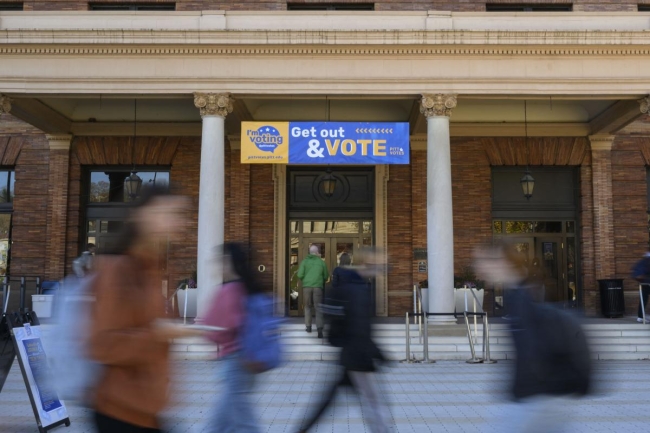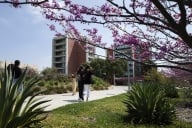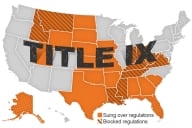You have /5 articles left.
Sign up for a free account or log in.

A polling site at the University of Pittsburgh on Election Day 2022. College students helped drive the second-highest youth turnout in a midterm last Tuesday.
Angela Weiss/AFP via Getty Images
In order to cast their ballots in last Tuesday’s midterm elections, students at the University of Michigan waited for up to six hours in lines that stretched hundreds long outside the campus’s polling sites.
As the sun set over Ann Arbor, the temperature dropped, but student voters stayed in line. They wrapped themselves in blankets distributed by the Washtenaw County Democratic Party, sipped on hot coffee provided by the city’s state representative-elect, and bided their time. The last vote—from a master’s student studying microbiology—was cast close to 2:00 a.m.
Clarissa Unger, co-founder and director of the Students Learn Students Vote Coalition, a nonprofit group of organizations dedicated to increasing student voter turnout, said Michigan was not the only campus where throngs of determined student voters waited into the wee hours of Wednesday morning.
“Just anecdotally, that was the case for campus polling locations across the country, and especially in battleground states,” she said.
 Preliminary exit data suggest that college students were part of a significant wave of young voters casting their ballots this cycle: 27 percent of young people aged 18 to 29 voted in last week’s midterms, according to a report from Tufts University’s Center for Information and Research on Civic Learning and Engagement, or CIRCLE.
Preliminary exit data suggest that college students were part of a significant wave of young voters casting their ballots this cycle: 27 percent of young people aged 18 to 29 voted in last week’s midterms, according to a report from Tufts University’s Center for Information and Research on Civic Learning and Engagement, or CIRCLE.
It’s the second-highest youth turnout in a midterm in three decades, and though their total numbers fell a few points below 2018 levels, young voters still made up about the same percentage of the electorate this year: 12 percent compared to 2018’s 13 percent. And in nine key battleground states—including Georgia, Nevada and Pennsylvania—CIRCLE estimates that the aggregate youth voter turnout was even higher, about 31 percent.
“Young people have made it very clear that they are here to stay as an electorate, regardless of who’s on the ballot,” said Kei Kawashima-Ginsberg, CIRCLE’s director.
Exit polls don’t ask voters if they’re enrolled at higher education institutions, so the numbers for student voters specifically won’t be available until well into 2023, when the Institute for Democracy and Higher Education (IDHE), also based at Tufts, releases its report, based on a comparison of voting records and enrollment data. But college students typically have much higher voting rates than the broader youth bloc: 40 percent of college students voted in the 2018 midterms compared to 28 percent of youth over all, according to the last IDHE report.
“Part of the reason for that is the climate of being around a college campus, where people discuss and learn about political issues, and there’s a lot of activism as well,” said IDHE director Nancy Thomas. “More discussion and activism begets more interest in voting, and I think that showed in this election.”
Feeling Heard, Turning Out: A Virtuous Cycle
As election results rolled in during the past week, they defied forecasts of a “red wave” from pollsters and political media. Democrats held on to the Senate, and the Republicans’ all-but-certain majority in the House is likely to be the narrowest since 1933. Young voters, it seems, had something to do with the surprise results: of those between 18 and 29 who voted last Tuesday, 63 percent voted for Democrats, according to CIRCLE.
Santiago Mayer, a senior at California State University, Long Beach, is the founder of Voters of Tomorrow, a student-led youth voter engagement organization. He said that while young voters were by no means a “blue wall”—he described Generation Z as more of a “lavender haze,” referencing a popular Taylor Swift song—he found that students were more receptive to appeals from Democrats because they have delivered on political promises like climate change legislation and student debt relief.
“There is a kind of culture of disillusionment, because the system has never really delivered for us,” said Mayer, who was 17 when he started VoT. “But our theory of change has always been that when you reach out to young people and deliver for us, we will turn out and vote for you … This election proved that theory.”
Kawashima-Ginsberg said the past decade of youth voter trends also point to greater youth investment in electoral politics.
“Ten years ago I think young people were not voting because they didn’t think that it had an impact,” she said. “I think this generation actually does believe in government and policies’ power to change systems and improve lives.”
That dedication extends beyond individuals casting their ballots; college students are increasingly involved in mobilizing their peers as well, and Tuesday saw a slew of initiatives from student-led voter turnout groups. Mayer said Voters of Tomorrow sent buses to Texas A&M University after the state shut down its campus polling site and delivered ponchos to the University of California, Irvine, when a rare Southern California rainfall threatened to disperse lines of student voters.
Sophia Shapiro, a junior at the University of Pittsburgh and the daughter of Pennsylvania’s governor-elect, Josh Shapiro, saw the value in mobilizing the student vote early on in her father’s campaign.
campaign.
“I worked with Students for Biden in 2020 and saw how that really motivated my campus,” she said. “So when my dad launched his campaign, I sat him down and said, ‘Dad, I want to do Students for Shapiro.’”
Students for Shapiro helped mobilize around 1,000 student volunteers at 50 campus chapters across the Keystone State. Those volunteers, she said, knocked on over 44,000 students’ doors in dorms and off-campus houses. They also reached more than 400,000 students via text and engaged in a digital campaign that included campaign messaging through Twitter, TikTok and—for the first time in a gubernatorial campaign—the popular app BeReal.
The campaign saw results: according to the CIRCLE report, 26 percent more young people voted for Shapiro than for his Republican opponent, Doug Mastriano, in a state where voters age 18 to 29 were projected to have an outsize impact.
“There’s a lot of issues, especially after the Dobbs decision, that impact us very directly and that really fire up young voters,” Shapiro said. “When that messaging comes from your peers and you meet them where they’re at, they’re far more likely to engage and take action.”
Casting Ballots Despite Unique Barriers
Thomas praised the high voter turnout that led to long lines on campuses like the University of Michigan but noted that waiting for hours in the cold could be a major deterrent—and it’s not the only one student voters face, she added.
“Students—particularly minority students—face barriers that other groups don’t,” Thomas said. “It means they have to be especially engaged.”
Thomas was particularly concerned about the added difficulty of voting by mail, since the 2020 election spurred a series of Republican-led state initiatives to complicate the identity verification process or restrict vote-by-mail eligibility. Easier voting by mail was likely at least partially responsible for the record 66 percent student voter turnout in 2020, Thomas said, considering students are often registered to vote in their home county and state, which may be different than their campus’s.
“Convenience really matters, to all Americans but particularly for college students,” she said. “Taking that away strikes me as deliberately repressive.”
For students who do vote in person, it can be hard to know which local polling site is theirs, Unger said, as one dorm’s precinct could be entirely different from another. That’s one reason the SLSV Coalition is pushing for more early voting access on campuses.
“If you go to vote on Election Day, the precincts are smaller,” she said. “Early voting sites typically serve any voters in the county, so it makes it much easier and more accessible.”
“It’s hard to not attribute some of the drop-off [in youth turnout between 2018 and 2022] to those barriers,” Mayer said. “At the same time, I think young organizers and activists were really creative in finding different ways to overcome them.”
More Institutions Promote Civic Engagement
Thomas said colleges and universities can play a significant role in helping students overcome these barriers—and that they’ve been increasingly committed to doing so since 2016.
The data bear this out. According to a report from the Student Vote Research Network, 528 colleges and universities submitted an action plan for student voter engagement in 2022, two more than in 2020 and almost double the number from 2018. (This paragraph has been updated to correct the source of the report.)
“Voter engagement is something colleges are playing an increasingly large role in for students,” Unger said. “Campuses are unique in that they have the ability to reach an entire population, and recently they’ve started to really utilize those systems and processes to reach every student in their community in a way that I don’t think other local institutions have figured out.”
Thomas said that institutional involvement is key in providing both informational resources—how and where to vote, what to bring, etc.—and in utilizing peer pressure as an effective tool for mobilization.
“On a college campus, even more than in most places, voting is a very social act, and it really helps when an institution engages students that way,” Thomas said. “At the end of the day, it comes down to what kind of campus culture is being created. It’s about what’s in the water.”









